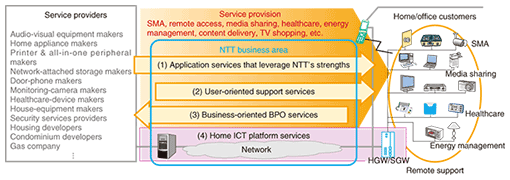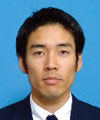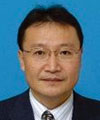 |
|||||
|
|
|||||
|
Special Feature: NGN Focus Vol. 8, No. 10, pp. 5–7, Oct. 2010. https://doi.org/10.53829/ntr201010sf2 Expansion of Home ICTAbstractAs broadband networks spread to an ever increasing number of households, there are growing expectations for Home ICT as a means of using a wide variety of devices connected to a home network and making daily life more secure and convenient. NTT is undertaking the strategic development of Home ICT as a new pillar of business growth.
1. IntroductionFrom here on, broadband and ubiquitous communication services for home use are expected to evolve from triple-play services to comprehensive information and communications technology (ICT) services (Home ICT) featuring the use of diverse networked devices closely tied to daily life. The NTT Group is developing a strategic plan for commercializing Home ICT as a new and important business area. 2. NTT business area in Home ICTHome ICT cannot be achieved without collaboration with a wide array of service providers in a framework that extends beyond the conventional scheme for providing communication services. Furthermore, it will not be accepted by customers unless it provides an environment in which they can use a variety of networked devices without worrying about safety and security. The business area targeted by NTT as part of this Home ICT expansion can be broadly divided into four types of services, as shown in Fig. 1 and listed below.
(1) New application services that leverage NTT”Ēs strengths such as home security, monitoring, and automation (SMA), media sharing, healthcare, and energy management. Although the main providers of Home ICT application services will be commercial service providers, NTT will provide services that drive the market launch of Home ICT. (2) Support services to enable customers unfamiliar with the operation of ICT equipment to use and enjoy Home ICT services without anxiety. They will simplify the use and configuration of services and provide one-stop technical support. (3) Business process outsourcing (BPO) services to provide service providers with business functions like primary fault handling, help desks, and collection services. (4) Platform business to provide common functions necessary for achieving diverse services 3. Customer-oriented servicesCustomer-oriented services revolve around support and applications. Support services can be performed onsite or remotely, and if both types are used effectively, it will be possible to provide support for the various types of problems that customers may encounter. In actuality, NTT Group companies are already pursuing a variety of support services. For example, the remote support service for personal computers provided by NTT EAST and NTT WEST has about two million subscribers and the onsite-support agent service provided by the NTT-WEST-HOMETECHNO companies has responded to more than 25,000 cases. These support services have a head start on Home ICT. NTT will also provide application services that leverage its expertise and know-how. Against the background of key social trends such as an increasing number of elderly households and double-income households and growing concerns about health and the environment, NTT is performing a comprehensive analysis of customer needs in individual households and is ranking SMA, media sharing, healthcare, and energy management as four banner services targeted for commercialization. SMA services will include security functions such as the ability to lock the door of one”Ēs home from anywhere via a mobile phone. Marketing surveys have indicated that a great proportion of customers intend to use such security services. At present, the number of households using home-security services provided by domestic security companies is on the order of one million, which is less than 2% of all households in Japan. Needless to say, there is still room for market expansion in this field. NTT expects SMA, as a home-security solution that is relatively easy to implement, to be adopted by a great number of households in the years to come. Media sharing means services that enable media like photos and videos to be shared with friends and others. To give some background, the penetration rate of digital cameras now stands at about 70%, and TV and hard-disk-drive recorders have recently begun to incorporate functions for playing back high-resolution digital photos. At the same time, people who are not especially adept at using personal computers still want to be able to use and enjoy digital photos without hassle. Connecting such devices to the broadband network can make it easy to share high-quality photos with parents or loved ones who live far away. 4. Role of service gatewayThe key to making it easy for customers to use a wide variety of services from remote support to SMA and media sharing is the service gateway (SGW). Devices connected to a home network use a variety of communication protocols such as Universal Plug and Play (UPnP), Digital Living Network Alliance (DLNA), and Network Basic Input Output System (NetBIOS). The SGW manages and controls these devices and performs protocol conversion to enable devices to cross-connect. It may be incorporated into a home gateway (HGW). Having an SGW or an HGW that incorporates an SGW installed in each home will simplify the introduction of services like SMA and media sharing that involve the linking of multiple devices. 5. Role of Home ICT platformThe core of the SGW is the OSGi [1] framework featuring modular software that can be added or updated via the network. NTT Laboratories is developing a Home ICT platform (item (4) in Fig. 1) that enables multiple service providers to share the SGW installed in a home and that comprehensively manages the functions needed to provide services. An important role of the Home ICT platform is to demonstrate an economic effect by enabling multiple service providers to share SGWs and platform functions and to reduce the cost of providing services to customers. Functions provided by the Home ICT platform include management of SGW software and remote management and remote access of home networks and devices. In the future, there are plans to provide functions for achieving device traceability and smart grids (energy management platforms) as a mechanism for supporting community and public activities like device recycling and ecological preservation. 6. Future outlookAs described above, Home ICT is an important service that enables anyone to easily and conveniently use a variety of networked devices that are becoming increasingly popular in the home. NTT will team up with a diverse array of service providers to advance the provision of support and application services and promote the spread of Home ICT. It will also support the launching of a consortium with service providers involved in Home ICT and the expansion of Home ICT platform trials in testbed environments. Reference
|
|||||














